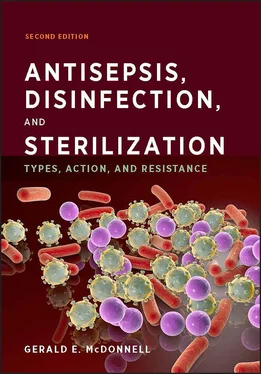1 Cover
2 PREFACE
3 ABOUT THE AUTHOR
4 IMPORTANT NOTICE
5 1 INTRODUCTION
1.1 GENERAL INTRODUCTION 1.2 DEFINITIONS 1.3 GENERAL MICROBIOLOGY 1.4 GENERAL CONSIDERATIONS FURTHER READING
6 2 PHYSICAL DISINFECTION2.1 INTRODUCTION 2.2 HEAT 2.3 COLD TEMPERATURES 2.4 RADIATION 2.5 FILTRATION FURTHER READING
7 3 CHEMICAL DISINFECTION3.1 INTRODUCTION 3.2 ACIDS AND ACID DERIVATIVES 3.3 ALKALIS (BASES) 3.4 ALDEHYDES 3.5 ALCOHOLS 3.6 ANILIDES 3.7 ANTIMICROBIAL DYES 3.8 BIGUANIDES 3.9 DIAMIDINES 3.10 ESSENTIAL OILS AND PLANT EXTRACTS 3.11 HALOGENS AND HALOGEN-RELEASING AGENTS 3.12 METALS 3.13 PEROXYGENS AND OTHER FORMS OF OXYGEN 3.14 PHENOLICS 3.15 ANTISEPTIC PHENOLICS 3.16 QACS AND OTHER SURFACTANTS 3.17 MISCELLANEOUS BIOCIDES OR APPLICATIONS FURTHER READING
8 4 ANTISEPTICS AND ANTISEPSIS4.1 INTRODUCTION 4.2 SOME DEFINITIONS SPECIFIC TO ANTISEPSIS 4.3 THE STRUCTURE OF SKIN 4.4 SKIN MICROBIOLOGY 4.5 ANTISEPTIC APPLICATIONS 4.6 BIOCIDES USED AS ANTISEPTICS FURTHER READING
9 5 PHYSICAL STERILIZATION5.1 INTRODUCTION 5.2 STEAM 5.3 DRY-HEAT STERILIZATION 5.4 RADIATION STERILIZATION 5.5 FILTRATION 5.6 DEVELOPING METHODS FURTHER READING
10 6 CHEMICAL STERILIZATION6.1 INTRODUCTION 6.2 EPOXIDES 6.3 LTSF 6.4 HIGH-TEMPERATURE FORMALDEHYDE-ALCOHOL 6.5 HYDROGEN PEROXIDE 6.6 OTHER OXIDIZING-AGENT-BASED PROCESSES FURTHER READING
11 7 MECHANISMS OF ACTION7.1 INTRODUCTION 7.2 ANTI-INFECTIVES 7.3 MACROMOLECULAR STRUCTURE 7.4 GENERAL MECHANISMS OF ACTION FURTHER READING
12 8 MECHANISMS OF MICROBIAL RESISTANCE8.1 INTRODUCTION 8.2 BIOCIDE-MICROORGANISM INTERACTION 8.3 INTRINSIC BACTERIAL RESISTANCE MECHANISMS 8.4 INTRINSIC RESISTANCE OF MYCOBACTERIA 8.5 INTRINSIC RESISTANCE OF OTHER GRAM-POSITIVE BACTERIA 8.6 INTRINSIC RESISTANCE OF GRAM-NEGATIVE BACTERIA 8.7 ACQUIRED BACTERIAL RESISTANCE MECHANISMS 8.8 MECHANISMS OF VIRAL RESISTANCE 8.9 MECHANISMS OF PRION RESISTANCE 8.10 MECHANISMS OF FUNGAL RESISTANCE 8.11 MECHANISMS OF RESISTANCE IN OTHER EUKARYOTIC MICROORGANISMS FURTHER READING
13 INDEX
14 End User License Agreement
1 Chapter 1 TABLE 1.1 Examples of various types of microorganisms TABLE 1.2 Some advantages and disadvantages of microorganisms TABLE 1.3 Comparison of general prokaryotic and eukaryotic structuresa TABLE 1.4 Helminths associated with disease TABLE 1.5 Examples of common fungi TABLE 1.6 Classification of protozoa, based on their motility mechanisms and mic... TABLE 1.7 Examples of pathogenic mycoplasmas TABLE 1.8 General differentiation of types of bacteria based on their microscopi... TABLE 1.9 Examples of gram-positive bacteria TABLE 1.10 Examples of gram-negative bacteria TABLE 1.11 Cell wall structures in mycobacteria and related organisms TABLE 1.12 Examples of extremophile archaea TABLE 1.13 Viral families, with examples of classifications, including size, pre... TABLE 1.14 Examples of viral diseases TABLE 1.15 Examples of bacterial, fungal, and algal toxins TABLE 1.16 Common examples of bacterial exotoxins TABLE 1.17 Examples of surrogate microorganisms used to test and verify antimicr... TABLE 1.18 Examples of standardized suspension tests TABLE 1.19 Examples of standardized carrier tests TABLE 1.20 Examples of simulated-use and/or in-use tests and/or guidelinesa TABLE 1.21 Bacterial-endospore species used to monitor and validate sterilizatio... TABLE 1.22 Examples of biological-indicator standards TABLE 1.23 A typical classification of chemical indicators TABLE 1.24 Examples of chemical-indicator standards TABLE 1.25 Examples of standards and guidelines for antisepsis, disinfection and... TABLE 1.26 Various constituents of formulated biocidal products TABLE 1.27 Examples of process variables in various disinfection/sterilization t... TABLE 1.28 Various components of cleaning formulations TABLE 1.29 Examples of common water contaminants and their effects
2 Chapter 2 TABLE 2.1 Examples of various standards and guidelines for heat disinfection TABLE 2.2 Wavelengths and energies of types of electromagnetic radiation TABLE 2.3 Types of UV radiationTABLE 2.4 IR wavelength rangeTABLE 2.5 Typical uses of filtration for liquid and gas applicationsTABLE 2.6 Classification of clean rooms based on number of ≥0.5-μm particles det...TABLE 2.7 Examples of standards and guidelines for disinfection and sterilizatio...
3 Chapter 3TABLE 3.1 Examples of various guidelines and standards on the use and applicatio...TABLE 3.2 Various types and sources of essential oilsTABLE 3.3 Other oxygen- and hydrogen peroxide-releasing compoundsTABLE 3.4 Comparison of sporicidal efficacies of liquid and gaseous hydrogen per...TABLE 3.5 Hydrogen peroxide-based synergistic formulations and processesTABLE 3.6 Various types of phenolic compoundsTABLE 3.7 Classification of surfactantsTABLE 3.8 Various biocides used on antimicrobial surfacesTABLE 3.9 Various types of proteins, peptides, and enzymes used as biocides
4 Chapter 4TABLE 4.1 Common or notable infections of the skinTABLE 4.2 Examples of various guidelines and standards on the use and applicatio...TABLE 4.3 Examples of biocides most widely used as skin antiseptics and washesaTABLE 4.4 Miscellaneous biocides used as antiseptics and their applications
5 Chapter 5TABLE 5.1 Common steam contaminants and their effectsTABLE 5.2 Typical qualities of WFI and “clean” steamaTABLE 5.3 Typical steam sterilization cyclesTABLE 5.4 Examples of standards and guidelines for steam sterilization applicati...TABLE 5.5 Typical steam sterilization cycles recommended for TSE-associated deco...TABLE 5.6 Examples of bacterial-spore resistance to dry heat at 160°CTABLE 5.7 Materials disinfected and/or sterilized by radiationTABLE 5.8 Typical doses of radiation for biocidal applicationsTABLE 5.9 Examples of standards and guidelines for radiation sterilization appli...
6 Chapter 6TABLE 6.1 Typical ethylene oxide sterilization process conditions, based on FDA-...TABLE 6.2 Examples of standards and guidelines for EO sterilization applicationsTABLE 6.3 Examples of standards and guidelines for LTSF sterilization applicatio...TABLE 6.4 Comparison of STERRAD hydrogen peroxide gas-plasma sterilization syste...
7 Chapter 7TABLE 7.1 Comparison of anti-infectives and biocidesTABLE 7.2 Widely used antibiotics (antibacterials) and their mechanisms of actio...TABLE 7.3 Widely used antifungal drugs and mechanisms of actionTABLE 7.4 Widely used antiviral drugs and mechanisms of actionTABLE 7.5 Widely used antiparasitic drugs and mechanisms of actionTABLE 7.6 Biocides with an oxidizing-agent-based mode of actionTABLE 7.7 Examples of products observed on reaction of oxidizing agents with ami...TABLE 7.8 Biocides with cross-linking- or coagulation-based modes of actionTABLE 7.9 Biocidal processes with transfer-ofenergy-based modes of actionTABLE 7.10 Biocides that act by disrupting the structures and functions of macro...
8 Chapter 8TABLE 8.1 Examples of intrinsic and acquired mechanisms of resistance to biocide...TABLE 8.2 Examples of bacterial responses to environmental stressTABLE 8.3 Differences observed in the expression of proteins during the hydrogen...TABLE 8.4 Classification of active-transporter systemsTABLE 8.5 Examples of bacterial efflux systems that have been shown to extrude b...TABLE 8.6 Protective cell surface structures external to the bacterial cell wallTABLE 8.7 Typical bacteria and fungi associated with biofilm formationTABLE 8.8 Biofilms and microbial response to antimicrobial agentsTABLE 8.9 Examples of known extreme resistance to biocides and biocidal processe...TABLE 8.10 Spore-forming bacteria and their significanceTABLE 8.11 Sporistatic and sporicidal concentrations of liquid biocidesaTABLE 8.12 Structures, components, and activities of endospores and their vegeta...TABLE 8.13 Examples of revival mechanisms that have been described following bio.
Читать дальше












